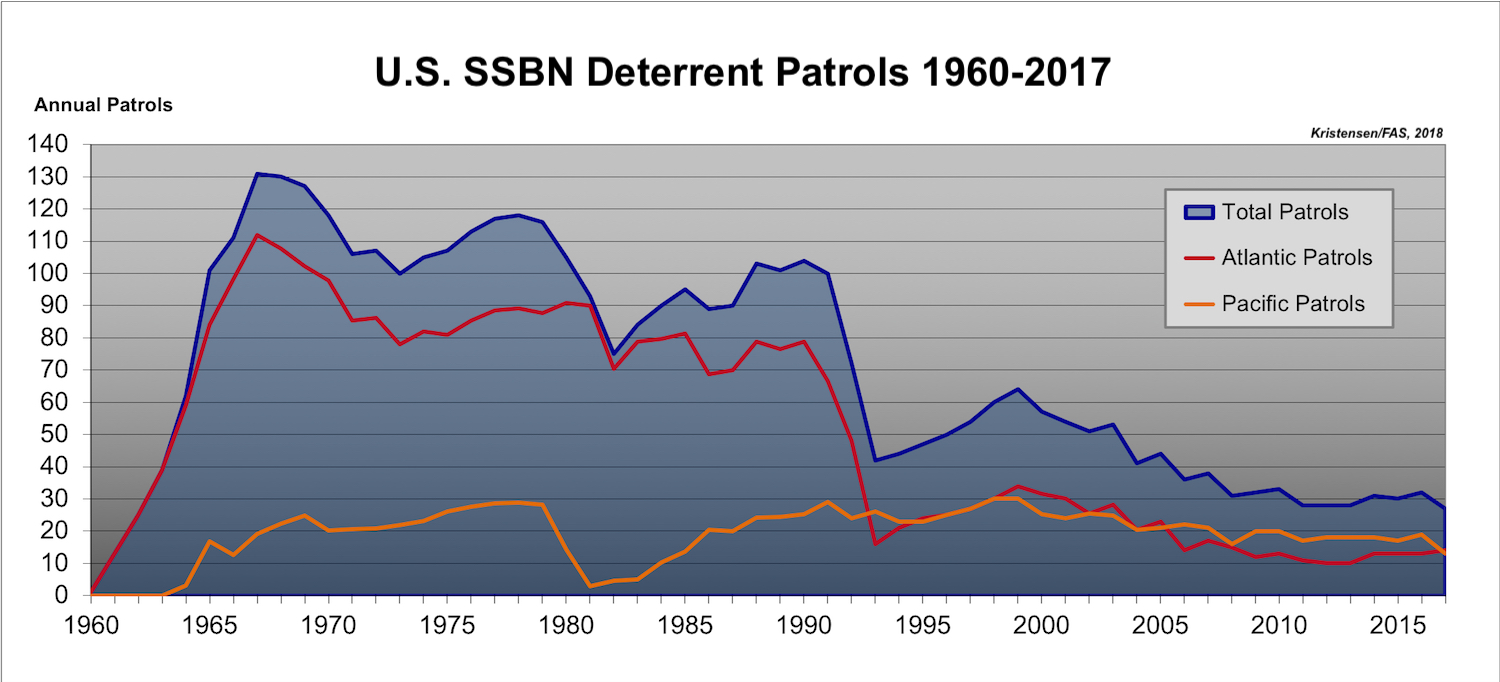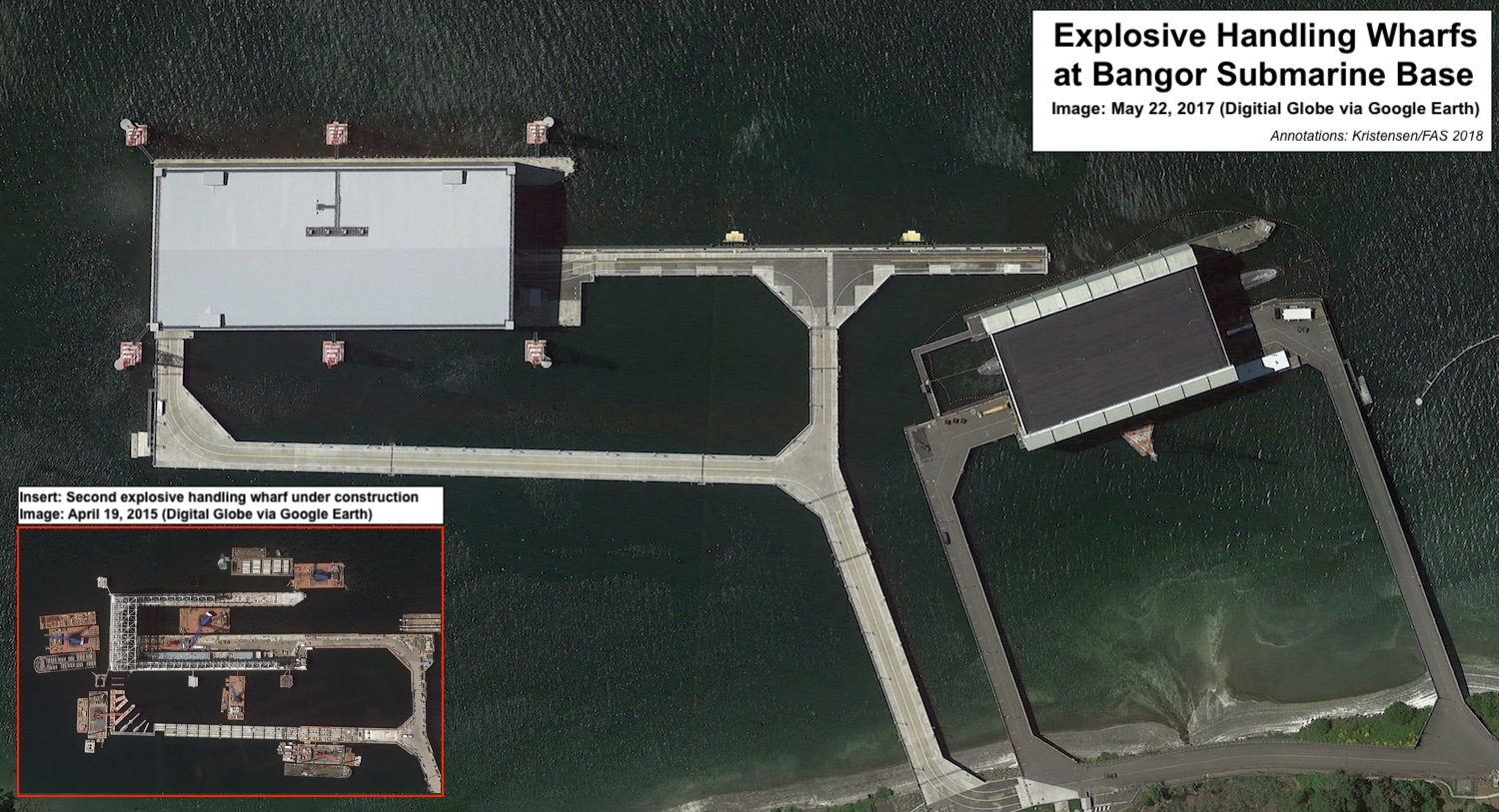US SSBN Patrols Steady, But Mysterious Reduction In Pacific In 2017

The U.S. SSBN fleet conducted 27 nuclear deterrent patrols in 2017, but with a mysterious reduction in the Pacific. Click graph to view full size.
By Hans M. Kristensen
Despite their age, U.S. nuclear ballistic missile submarines (SSBNs) continue to carry out strategic deterrent patrols at a steady rate of around 30 patrols per year, according to data obtained from the U.S. Navy under the Freedom of Information Act (FOIA) by the Federation of American Scientists’ Nuclear Information Project.
Yet the data shows the U.S. SSBN fleet conducted a total of 27 patrols in 2017 (five less than in 2016), the lowest number of patrols in as single year since the early-1960s when SSBN deterrent patrols began. Even so, the fluctuations are small, modern SSBNs patrol longer than 1960s SSBNs, and the overall patrol number has remained relatively steady for the past decade.
Nonetheless, the new data reveals a mysterious reduction of deterrent patrols in the Pacific in 2017: a nearly one-third drop from the 2016 level of 19 patrols to only 13 in 2017. The drop in Pacific patrols in 2017 happened despite completion of a second Explosive Handling Wharf at the Kitsap-Bangor Submarine Base that same year, which is intended to allow for additional maintenance needed as the submarines get older.

The drop in Pacific SSBN patrols happened despite completion of a second explosive handling wharf at Bangor. Click on image to view full size.
It is unknown what has caused the Pacific reduction. The size of the SSBN fleet at Kitsap-Bangor Submarine Base hasn’t changed, the Navy and U.S. Strategic Command haven’t announced a change in strategy, and there has been no public reports about serious technical problems that could have forced the reduction.
In any case, the SSBN fleet appears have picked up some patrol slack in early-2018. In mid-March this year, the Navy told Congress that SSBNs “conducted 33 strategic deterrent patrols…over the past year,” or five more than the 27 patrols the FOIA release says were conducted through 2017.
Coinciding with the reduction in Pacific patrols, the smaller Atlantic SSBN fleet (6 boats versus 8 in the Pacific) increased its patrols slightly in 2017 (from 13 to 14). As a result, the Atlantic SSBNs in 2017 conducted more deterrent patrols than the Pacific SSBN fleet for the first time since 2005 (14 patrol versus 13 patrols, respectively) when the majority of the SSBN force was shifted to operations in the Pacific.
Altogether, between 1960 and 2017, the US SSBN fleet conducted a total of 4,083 deterrent patrols, which adds up to an average of just over three patrols per submarine per year.
The Navy occasionally announces in public when SSBNs complete deterrent patrols, and less frequently when they begin a patrol. But it far from announces all of them. During the past decade, for example, only about one-third of the annual patrols were announced on average.
The duration of SSBN patrols can vary considerably. The Ohio-class SSBN is designed for 70-day patrols but individual patrols can be cut short by technical difficulties, in which case another submarine will have to take over the assignment. Similarly, sometimes a submarine approaching the end of its scheduled patrol will be forced stay out longer cause the submarine that was supposed to replace it delayed by technical problems. In 2014, for example, the USS Pennsylvania (SSBN-735) stayed out for 140 days – more than four-and-a-half months or twice its normal patrol duration – because of maintenance problems with its replacement submarine. The Navy said it was the longest patrol ever conducted by an Ohio-class SSBN. Again, toward the end of 2017, the USS Pennsylvania stayed on patrol for 116 days.

The USS Pennsylvania (SSBN-735) arrives at Kitsap-Bangor Submarine Base on June 14, 2014, after a 140-day deterrent patrol – the longest ever for an Ohio-class SSBN. Click image to view full size.
The USS Pennsylvania was commissioned in September 1989 – 29 years ago – and completed a mid-life complex reactor refueling overhaul in 2012. The boat is scheduled to be retired in 2031 at age 42, the year the first new Columbia-class (SSBN-826) will sail on its first deterrent patrol.

The 14 Ohio-class SSBNs will start retiring in 2027 and be replaced by 12 Columbia-class SSBNs from 2031. During much of the 2020s, the Navy will have more deployable SSBNs than it needs. Click graph to view full size.
Of the Navy’s 14 Ohio-class SSBNs, 12 are considered deployable (the 13th and 14th boats are in refueling overhaul). Of those, an average of 8-9 are normally at sea, of which 4-5 are thought to be on “hard alert” within range and position of their priority target strike package. The deployed SSBN force normally carries just over 200 SLBMs with around 900 warheads. Another 1,000 SLBM warheads are in storage for potential upload if necessary.
The last two SSBN reactor refueling overhauls will be completed in 2020-2021, after which the Navy will be operating 14 deployable SSBNs, or two more than it needs for deterrent operations. At that point, the two oldest SSBNs – USS Henry M. Jackson (SSBN-730) and USS Alabama (SSBN-731) – can probably be retired.
This publication was made possible by generous grants from the John D. and Catherine T. MacArthur Foundation, Ploughshares Fund, and the Carnegie Corporation of New York. The statements made and views expressed are solely the responsibility of the author.
The FY2026 National Defense Authorization Act (NDAA) paints a picture of a Congress that is working to both protect and accelerate nuclear modernization programs while simultaneously lacking trust in the Pentagon and the Department of Energy to execute them.
While advanced Chinese language proficiency and cultural familiarity remain irreplaceable skills, they are neither necessary nor sufficient for successful open-source analysis on China’s nuclear forces.
Satellite imagery has long served as a tool for observing on-the-ground activity worldwide, and offers especially valuable insights into the operation, development, and physical features related to nuclear technology.
This report outlines a framework relying on “Cooperative Technical Means” for effective arms control verification based on remote sensing, avoiding on-site inspections but maintaining a level of transparency that allows for immediate detection of changes in nuclear posture or a significant build-up above agreed limits.